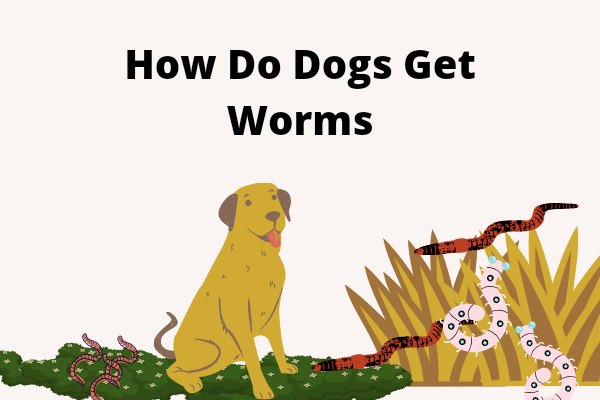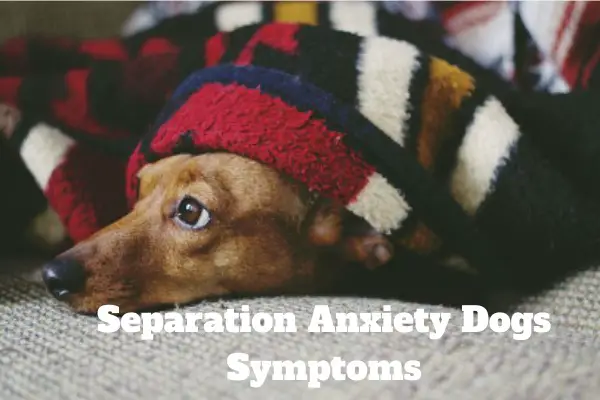How Do Dogs Get Worms: 13 Ways Dogs Get Worms

Most dog owners always ask how do dogs get worms because it’s very frustrating to live with a dog that has worms.
Don’t worry again after reading this post you will understand how dogs get worms and how to protect your dog from worms.
You will also know the types of worms that can attack dogs and the symptoms associated with worms.
Am not a veterinarian, but I have had dogs all my life, I know what it takes to deal with dogs living with worms.
Dogs can get worms from their environment or from other animals. They have a variety of types of worms that they can get.
Some are more harmful than others. These parasites can be transmitted to people, so it is important to keep your dog’s health in mind when caring for them.
Worms are parasitic organisms that can cause a variety of problems for dogs if they don’t receive treatment.
Dogs can get worms by ingesting them on the ground, or by eating prey animals that have worms.
Worms can also be passed to puppies through their mother’s milk.
Have you ever seen your dog scratching itself, lost weight, or having diarrhea? Maybe they even have worms. It’s possible that your dog has worms and doesn’t know it!
Learn more about how dogs get worms, symptoms, prevention, and how to treat them here!
How Do Dogs Get Worms
Ingesting contaminated soil or excrement containing eggs or juvenile worms (larvae) transmitted from other infected animals in the environment is a typical way for your dog to get worms.
Drinking out of an infected water bowl, licking themselves after urinating or defecating in the yard, eating raw meat contaminated with roundworms, and from fleas on other animals are also ways dogs get worms.
These are the basic ways dogs can get worms from their environment. But this is not the only way dogs get worms.
Let’s now discuss these ways.
Here are some of the most common ways how dogs could get worms:
1. Dogs get worms from licking themselves
Tapeworms can be passed on to your dog if your dog mistakenly swallows fleas while licking itself or during self-grooming.
Once the flea host has been eaten and digested, the tapeworm larva can attach to the wall of your dog’s intestines and grow to adulthood.
Dogs can also get other types of worms through grooming if the dog mistakenly swallows worm eggs or larva.
2. Dogs get worms from eating worm larvae or eggs
Diseased animals’ droppings deposit roundworm and whipworm eggs in the soil.
These eggs can survive for long periods of time in the soil, even in harsh climatic conditions.
Dogs can become infected by accidentally ingesting these eggs, such as through sniffing or licking the ground.
Hookworms can be caught inadvertently by your dog eating hookworm larvae found in the soil.
Intimate skin contact with larvae left in soil or sand can also lead to hookworm infection.
The larvae, which are microscopic living worms, may burrow through the skin with their feet.
3. Dogs get worms from drinking worm-infested water
Flies prefer moist surfaces such as water and deposit eggs on them, indicating that the water has been contaminated with worms.
When a dog drinks from polluted water, he or she ingests the worms and becomes ill.
Make sure you don’t leave any open water in your house since you never know when your dog might want to drink from it.
4. Dogs get worms from their mother
Hookworm and roundworm larvae can be passed on to pups by pregnant and nursing dogs if they cross the placenta.
These larvae can also enter the mammary glands and pass on to puppies when they are feeding.
Hookworms, like roundworms, develop in the small intestine of your dog over time.
Worms can also be passed to puppies through their mother’s milk.
5. Dogs get worms from eating a worm-infested food
Eating worm-contaminated food is the most common method for dogs to obtain worms, and this can happen if you offer your dog leftover food.
Leaving your dog’s food out in the open will attract flies, and these insects can end up dropping worm eggs in the exposed food.
Make sure to seal the bag containing your dog’s food tightly every time you remove food from it.
Dogs can also get worms if they eat in the same bowl with another worm-infected pet.
6. Dogs get worms from eating a worm-infested feces
Intestinal worms are transmitted to dogs when they ingest contaminated feces containing eggs or immature worms (larvae) transferred from other infected animals in the environment.
When the swallowed eggs hatch, the larvae travel through the tissues of various organs, including the lungs and liver, before returning to the small intestine to mature.
7. Dogs get worms from hunting a worm infected rodents
Most dogs have strong territorial instincts and will not share their space with other creatures, such as rats.
This will undoubtedly force a dog to pursue a rodent regardless of the outcome of the chase.
If your dog follows after an infected rabbit or mouse, there’s a good risk he’ll get sick as well.
8. Dogs get worms from unkept gardens around the house
Worm larvae are found in the garden under leaves, and if they come into touch with a dog, they are transferred to the dog’s skin to continue their growth.
Dogs like playing in the garden, which makes it simpler for them to pick up worms.
If the leaves are moist, don’t let your dog into the garden.
9. Dogs get worms from other infected pets
Dogs may catch worms from other sick pets within or outside their house, as amusing as it may sound.
So be cautious while you’re out with your dog or when he interacts with other animals.
Because it might be difficult to see a dog with worms, always keep your dog secure.
10. Dogs get worms from eating a worm-infested raw meat
Most meats become infected when flies land on them lay eggs or carry worms into the flesh.
While this only affects dogs that consume raw or cooked meat, it is suggested that you maintain the area where your dog’s food is processed clean.
May microorganisms are attracted to raw or cooked meat and will not leave until they have landed on it. If flies land on raw meat, the flesh may get infected.
Keep your dog dishes clean at all times to avoid flies settling on them and laying eggs.
11. Dogs get worms from an infected mosquito bite
Infected mosquito bites or the ingestion of Dirofilaria immitis-infected meat or food are the two main ways heartworms are spread to dogs.
In dogs, heartworm infection leads to severe lung disease, heart failure, organ damage, and death.
When dogs are bitten by mosquitoes carrying the parasite, they get afflicted with heartworm.
12. Dogs get worms from unkept human footwear
By roaming around the area where you store your shoes, dogs might pick up parasites like worms.
As you move from outside to inside, you can’t be sure your shoes aren’t carrying worm eggs under them.
Parasites may be found nearly anywhere, including on human pathways, and they can stick to your shoes’ soles.
Because worm eggs may lay dormant for months, they’re easy to discover on clothing and shoes.
13. Dogs get worms from potted plants around your home
If your dog comes into contact with worm eggs under the leaves of potted plants around your home, he may get worms.
Pests can lay eggs under the leaves of potted plants, which is a possibility if you have potted plants around your house that you water.
Parasites may survive in the soil that we use to pot our indoor plants and flowers. Indoor cats can get worms through the same route.
There’s a high chance your dog may pick up worms if he comes into contact with this dirt.
Symptoms of worms infestation in dogs
Here are the common symptoms of worm infestation in dogs:
- Anemia
- Continues diarrhea
- Excessive scooting and chewing at their bottom
- Persistent vomiting
- Regular coughing
- Dull fur
- Sudden loss of appetite
- Rapid weight loss
- Swollen belly
- Mucus or blood in feces
- Worms in feces
- A suddenly decreased inactivity
- Signs of heart failure
- Unnecessary weakness
- Worms in dog vomit
- Visible segments that look like grains of rice attached to the fur around their bottom
How to diagnose worms in dogs
While tapeworms may be seen in a dog’s stool, other types of intestinal worms are usually discovered by looking at eggs in a stool sample under a microscope.
If your dog exhibits any of the symptoms, your veterinarian will request a stool sample.
Even if your dog displays no symptoms, it’s a good idea to bring a sample of his excrement to your veterinarian for his annual examination.
Heartworms are usually detected by a blood test.
In rare cases, however, a radiograph, ultrasound, or echocardiogram may be required.
To treat various forms of intestinal parasites and heartworms, your veterinarian may prescribe deworming medications as well as preventative therapies.
How to prevent worm infestation in dogs
There are many ways to prevent worm infestation in dogs, one of the most effective ways is to deworm your dog based on your veterinarian’s advice.
Here are some common ways you can prevent worm infestation in dogs:
- Teach kids to always wash their hands after playing outside or handling a dog or cat.
- Keeping their environment clean
- Proper and regular grooming
- Use flea control system
- Rodent control should be paramount
- Stop your dog from eating the green grass outside your door in the morning.
- Keep your dog’s water bowl away from the windows and doors.
- Allow your dog to drink from a watering can that has been filled with water for longer than two days.
- Keep your dog away from uncooked eggs.
- Ensure that your kittens and puppies are dewormed by a veterinarian.
- Make sure your dog isn’t eating infected raw meat.
- Keep your dog away from any suspected pets.
- Do not go barefoot or garden in places where you will be using your hands.
Types of worms found in dogs
Here are the common types of worms found in dogs:
Roundworms
Roundworms are intestinal parasites that can infect your dog by their mother’s milk, contact with or ingestion of larvae in a polluted environment, or by eating an infected animal such as a bug or mouse.
Roundworms attach themselves to the lining of your dog’s intestine and feed on his blood.
Roundworms can proliferate in your dog’s intestine and lay eggs, which are then passed through the feces.
Roundworm larvae emerge from the eggs and dwell in the soil.
By digesting infected dirt or soil, these larvae might infect your dog again.
Tapeworms
Tapeworms are spread by fleas, which are eaten by dogs.
The gut where tapeworms attach absorbs part of the dog’s nutrition.
Each segment of the tapeworm is roughly the size of a grain of rice.
These are excreted in the dog’s feces and can be observed near the anus.
Tapeworms can be killed with an injection or a pill.
Humans can get tapeworms as well, but they do not catch them from sick pets except through the ingestion of worm eggs.
Whipworms
Whipworms can be found in the junction of the small and large intestines. They drink the blood of their hosts here.
They can be picked up by dogs from polluted soil or when grooming.
When huge numbers of whipworms are embedded in the gut, they can produce bloody diarrhea.
Whipworms can be treated with certain heartworm preventives, and whipworms can be treated with an oral dewormer.
Hookworms
Hookworms are intestinal parasites that infect your dog’s intestines by consuming larvae in a polluted environment.
The parasite attaches itself to the lining of your dog’s intestine and feeds on his blood.
These parasites subsequently multiply inside your dog’s intestine and lay eggs, which are eventually expelled in canine feces.
The hookworms larvae emerge from the eggs and dwell in the soil.
Hookworm larvae can infect your dog by coming into touch with his skin, swallowing infected dirt or soil, or licking his hair.
Heartworms
Heartworms are transmitted to dogs through mosquito bites.
Heartworm may grow to be 14 inches long and lives in the heart and arteries that transport blood from the heart to the lungs.
Heartworms impact how the heart works and how blood clots, and if left untreated, they can lead to death.
Heartworm prevention is effective when taken on a monthly basis.
If your dog is sick, he or she may cough, have difficulty breathing, and exhibit other symptoms.
Wrapping up on how do dogs get worms
As if we didn’t love our dogs enough already, they’re also the only animals that share food and drink with us.
This means they also share any parasites we may have!
Worms are one of those things that can make a dog sick, so it’s important to know the signs of worms in dogs.
The most common signs of worms in dogs are weight loss, vomiting or diarrhea, and lethargy.
You should also watch for blood in the vomit or stool, as well as changes in appetite.
Here is how to improve your dog’s health.
If you think your dog may have worms, you should take them to a vet to be tested for this parasitic condition.

![Are Seizures Common in Beagles [Causes, Signs & Treatments] Are Seizures Common In Beagles](https://petcreeks.com/wp-content/uploads/2021/04/Are-Seizures-Common-In-Beagles.jpg)
![10 Best Ways To Keep Fleas Off Dogs [Explained] Best Ways To Keep Fleas Off Dogs](https://petcreeks.com/wp-content/uploads/2021/04/Best-Ways-To-Keep-Fleas-Off-Dogs.jpg)



